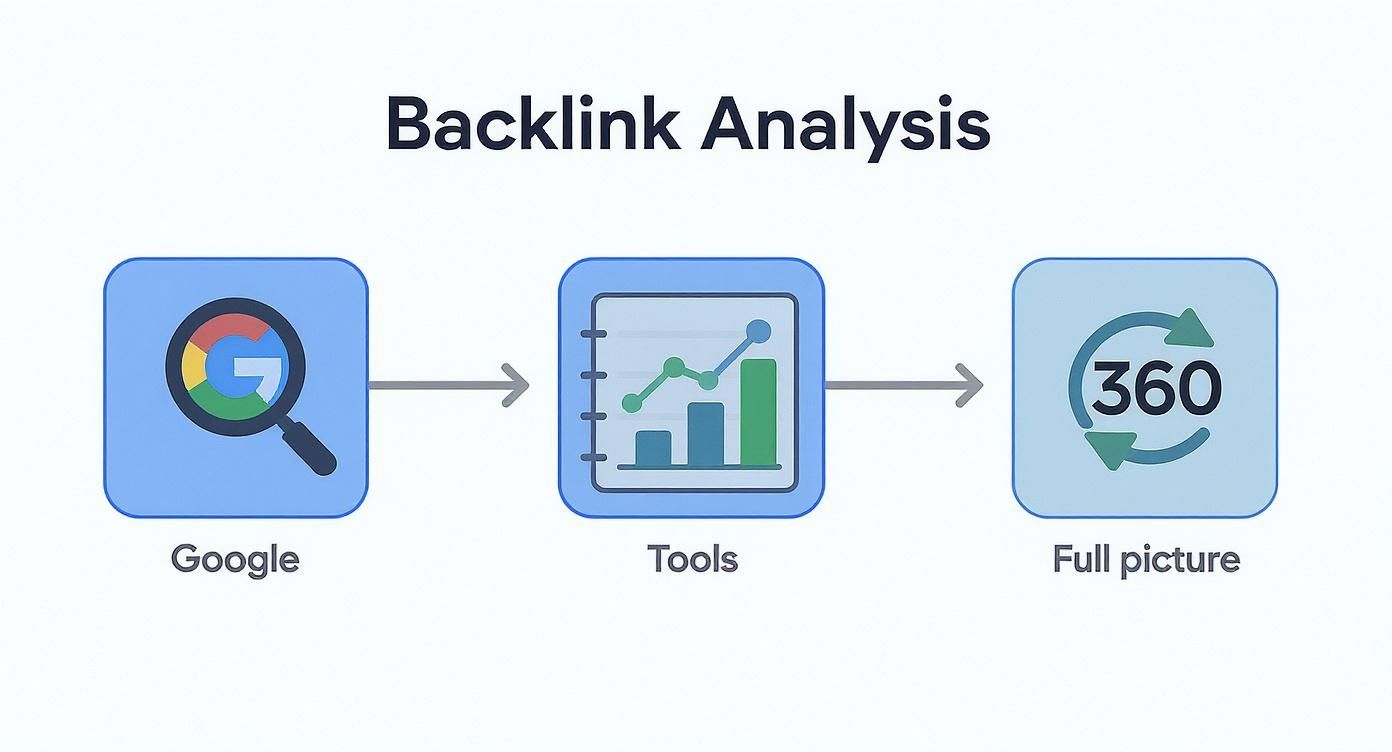Before you start messing around with complicated search queries or expensive third-party tools, your most reliable backlink data is already waiting for you inside Google Search Console (GSC). This is your ground truth—a direct, no-nonsense report from Google on exactly how it sees your site's link profile.
Think of it as your official starting point for any real backlink analysis. It’s free, it's accurate, and it's coming straight from the source.
If you haven’t set it up yet, that’s your first move. It’s non-negotiable for any serious website owner. We have a complete walkthrough that shows you how to set up Google Search Console to get you started.
Navigating the Links Report
Once your site is verified and ready to go, finding this data is a piece of cake. Just look for the 'Links' section in the left-hand sidebar. GSC neatly organizes your entire link profile into a few key reports that are immediately useful.
You’ll see two main sections that you’ll want to pay close attention to:
- External links: These are the backlinks you're looking for—the ones pointing from other websites to yours. This report breaks down your most linked pages and the top domains linking to you.
- Internal links: This shows you how you’re linking between your own pages. This is just as important for your site structure and spreading authority around your site.
This dashboard gives you a clean, unfiltered overview of your link ecosystem, free from the noise you might get from other crawlers.
The report below shows an example of what you'll see in the 'Top linking sites' section. It's a straightforward list of the domains sending the most links your way.

This view lets you quickly spot your biggest supporters and start analyzing the quality of the domains that are vouching for you.
Interpreting Your Backlink Data
Just seeing the data isn't enough; you have to know what it means. The "Top linking sites" report, for example, shows you which external domains are linking to you most often. Take a good look at that list. Are these authoritative, relevant sites in your industry, or is it a bunch of low-quality directories and spammy blogs?
Actionable Insight: If you're a Kansas City-based law firm, a link from the UMKC School of Law website is a high-quality, relevant backlink. A link from a random, low-traffic blog about pet grooming is not. GSC helps you spot these differences instantly, giving you a quick health check on your link profile.
This information isn't just about quantity, either. One study found that pages ranking #1 on Google have, on average, 3.8 times more backlinks than the pages ranking from #2 to #10. This just goes to show how critical a strong backlink profile is for landing those top-tier rankings.
Use Google Search Operators for Backlink Discovery
While Google Search Console gives you the official story on your own website, it tells you nothing about your competitors. That's where you have to get a little creative.
To find backlinks on Google without fancy, paid tools, you need to think like an old-school SEO and use advanced search operators. These are simple text commands that turn a standard Google search into a powerful reconnaissance tool.
Think of search operators as a secret language that Google understands. By using commands like site:, intext:, and the - (minus) symbol, you can slice through billions of web pages to find exactly what you’re looking for. It's a completely free technique that’s perfect for uncovering competitor backlinks, finding guest post opportunities, and spotting mentions of your brand across the web.

Uncovering Mentions and Links
One of the simplest yet most effective ways to find potential backlinks is to see who's already talking about your competitors. The goal is to find every single mention of their brand name except on their own website. This quickly reveals articles, reviews, interviews, and forum discussions where they’ve earned a link.
Here’s the exact search query to use:
"competitor brand name" -site:competitor.com
Let's break that down real quick:
- "competitor brand name": Using quotation marks forces Google to search for that exact phrase.
- -site:competitor.com: The minus sign is your exclusion tool—it tells Google to ignore any and all results from their own domain.
This simple query instantly shows you every other website that has mentioned them, giving you a ready-made list of potential link targets. After all, if they're writing about your competitor, there's a good chance they'd be interested in hearing from you, too.
Finding Specific Link Opportunities
You can get even more specific by combining operators to find certain types of content. For instance, if you want to find guest posting opportunities in your niche, you can search for sites that are actively asking for contributors.
Try a search query like this one:
"your industry" + "write for us"
This command tells Google to find pages that contain both your industry keyword (like "Kansas City real estate") and the exact phrase "write for us." This immediately filters your results down to blogs and publications that are open to guest submissions, saving you hours of manual searching.
Pro Tip: Don't just stop at "write for us." You can easily swap that phrase with alternatives like "become a contributor," "guest post guidelines," or "submit an article" to uncover even more opportunities that others might miss. This simple variation can seriously expand your list of potential outreach targets.
To help you get started, I've put together a quick reference table of the most useful search operators for backlink hunting.
Essential Google Search Operators for Finding Backlinks
This is a quick reference guide to the most effective search operators and practical examples for backlink analysis.
| Operator | Function | Example Search Query |
|---|---|---|
" " |
Searches for the exact phrase inside the quotes. | "digital marketing strategies" |
- |
Excludes a specific word or site: from the results. |
"backlinko" -site:backlinko.com |
site: |
Restricts the search to a single website. | site:forbes.com "guest post" |
intext: |
Finds pages containing a specific word in the body text. | intext:"contribute an article" |
intitle: |
Finds pages containing a specific word in the title. | intitle:"guest post guidelines" |
+ |
Forces Google to include a specific word or phrase. | "saas marketing" + "write for us" |
Mastering a few of these operators is a game-changer. They not only help you understand how to find backlinks on Google but also reveal the types of content and platforms that are actively linking out to businesses just like yours.
By using these manual search techniques, you can build a powerful, organic link-building strategy without spending a dime on expensive software.
Reverse Engineer Your Competitor's Backlink Strategy
Getting a handle on your own backlink profile is just the starting line. The real growth opportunities often come from peeking over your competitor's shoulder to see what’s working for them. By methodically taking apart their link-building strategy, you can uncover proven tactics and high-value link sources without having to reinvent the wheel.
This isn’t about just copying what they do. It’s about spotting the patterns that fuel their success and then adapting those winning strategies to fit your own brand. You can actually kick off this whole reverse-engineering process for free using the Google search operators we just covered.
Identify Their Top Content Assets
First things first, you need to pinpoint which pages on your competitor's site are absolute link magnets. Is it a groundbreaking industry study they published? A massive, in-depth "how-to" guide? Or maybe a free tool that solves a common headache for people in your industry?
These are what we call linkable assets—content so valuable that other websites can't help but reference it.
You can start digging for these with a simple, targeted search. For example, if you were analyzing a marketing giant like HubSpot, a search like site:blog.hubspot.com intext:"data from" could quickly surface original research reports that have likely earned them a ton of high-quality links.
Actionable Insight: Let's say you're a local Kansas City SEO agency. By analyzing a competitor, you discover their blog post "10 Marketing Mistakes KC Businesses Make" has earned links from the local Chamber of Commerce and several business blogs. This is a clear signal that creating a superior, more in-depth guide on a similar local topic could attract the same type of high-authority links.
This kind of analysis pulls you out of the guessing game. Instead of wondering what to create next, you can focus your resources on content formats with a proven track record of attracting authority-building links.
Uncover Their Most Valuable Referring Domains
Once you know what content is getting all the attention, the next logical step is to figure out who is linking to it. Finding your competitor's top referring domains hands you a ready-made priority list of websites to target for your own link-building campaigns.
While you can use the link: operator, just remember its limitations—it only gives you a sample, not the full picture. For better results, get creative and combine it with other search queries. A search like "competitor brand" "resource page" -site:competitor.com can unearth resource lists that mention them, which are often prime targets for outreach.
Look for patterns in the kinds of sites that link to them:
- Industry Blogs: Are they getting featured in expert roundups or interviews a lot?
- News Outlets: Do they earn links from digital PR mentions and press releases?
- Educational Institutions: Are their studies or tools cited in academic resources?
While the way Google views backlinks has definitely evolved, their importance is still undeniable. By 2025, backlinks are projected to be the third most significant Google ranking factor. One study that analyzed top search results found that a staggering 96.3% of pages in the top 10 have over 1,000 unique backlinks, confirming they remain a powerful signal of authority.
Understanding these link sources is your roadmap. If a competitor is consistently getting love from a specific group of bloggers, you know exactly where to focus your relationship-building efforts. You can also explore different link-building tactics, and it’s helpful to understand the nuances between them, such as knowing what a reciprocal link is and when it's appropriate to use one. By uncovering these strategic patterns, you can build a smarter, more efficient campaign that prioritizes proven tactics over guesswork.
Learn to Analyze Backlink Quality, Not Just Quantity

Finding a long list of backlinks pointing to your competitor’s site can feel like you've struck gold. But hold on—it's absolutely critical to remember that not all links are created equal. In the world of SEO, quality will always crush quantity.
Let me put it this way: a single, authoritative link from an industry-leading site like Forbes can provide more SEO value than a hundred links from irrelevant, low-authority blogs. The real skill isn't just counting links; it's learning to spot the difference between a powerful, trust-building backlink and one that's worthless or even harmful. This evaluation is what separates a scattered link-building effort from a focused campaign that actually moves the needle.
The Three Pillars of Link Quality
When you find a backlink—whether it’s pointing to your site or a competitor’s—you need to break down its fundamental quality. This analysis really boils down to three core elements that Google and other search engines care about most.
- Relevance: How closely related is the linking site’s content to your own? A link from a local Kansas City marketing blog to a local bakery is highly relevant. A link from a Russian gambling site is not. It's all about context.
- Authority: How trustworthy and established is the linking domain? Established sites with a long history of publishing quality content pass more authority, or "link equity." A brand-new site with no history passes virtually none.
- Placement: Where is the link on the page? A link placed naturally within the body of an article carries far more weight than one buried in a footer or a massive directory list.
Think of it this way: a recommendation from a respected expert in your field is far more valuable than a hundred random mentions from people who know nothing about your business. Search engines view backlinks in much the same way.
A healthy backlink profile is not just about numbers; it's a reflection of your site's reputation across the web. Focusing on quality links from relevant, authoritative sources is the most sustainable way to build long-term trust with search engines.
Your Practical Quality Checklist
Before you decide to chase a similar link for your own site, run it through this quick checklist. This simple evaluation can save you from wasting hours on links that won't provide any real benefit. It’s an essential step in building a strong and resilient what is a backlink profile for your business.
Ask yourself these key questions about every link you analyze:
- Is the Linking Site Topically Relevant? Does the website operate in your niche or a closely related one? A strong "yes" here is a great start.
- Does the Site Have Real Traffic? Use an SEO tool to get a rough estimate. A site with zero traffic is a huge red flag that it might be a spam site or part of a link farm.
- Is the Link Contextual? Is it placed within the main content of a page, surrounded by relevant text that adds value to the reader?
- Is the Anchor Text Natural? The text used for the link should make sense in the sentence, not be stuffed with exact-match keywords.
- Is the Site Well-Maintained? Does it look professional and publish fresh content, or does it look like an abandoned, spammy blog from 2010?
If a backlink checks all these boxes, it's a high-quality target worth pursuing. If it fails on a couple of these points, your time is better spent elsewhere.
Layer Free Tools on Top of Google for the Full Picture
Google Search Console and a few clever search operators give you a fantastic starting point, but they don't show you the whole story. To get a real competitive edge, you need to pair Google's data with specialized free tools that can fill in the blanks. This combination turns a simple sketch of a backlink profile into a detailed, actionable blueprint.
Think of it this way: Google Search Console is your internal report card. It's incredibly accurate for your own site, but it's completely blind to what your competitors are doing. Free backlink checkers, on the other hand, are like private investigators. They crawl the entire web to piece together a picture of everyone's links, giving you the external context you're missing.
Unlocking Deeper Backlink Metrics
The biggest win from these free tools is the specific data they provide. While Google shows you who is linking to you, freemium tools reveal much more about the strength and nature of those links. This is where you can start digging into the details that separate a good backlink profile from a great one.
Using the free versions of popular SEO platforms like Ahrefs or Semrush, you can quickly find:
- Total Backlink Count: Get a solid estimate of the total links pointing to a competitor, which serves as a quick benchmark for comparison.
- Anchor Text Distribution: See the exact phrases people are using to link to a site. This is huge for understanding how a site is perceived and which keywords it’s associated with.
- Dofollow vs. Nofollow Ratio: Instantly see the percentage of a site's links that pass authority (dofollow) versus those that don't. A high ratio of dofollow links often signals a much stronger profile.
This extra layer of information is crucial. It helps you understand the strategy behind the links, not just their existence.
Cross-Referencing Data for a 360-Degree View
The real power move is combining what you find from both sources. For example, you might use a Google search operator to discover a competitor's most important piece of content. Then, you can plug that specific URL into a free backlink checker to see exactly how many domains link to it and what their collective authority looks like.
This cross-referencing process allows you to verify and enrich your findings. You can confirm the strength of a linking domain by looking at metrics like Domain Authority or Domain Rating—concepts closely tied to the idea of what is page authority. These scores help you prioritize which of your competitor’s links are most valuable and actually worth chasing.
Actionable Insight: Let's say GSC shows you earned a new backlink from a blog you don't recognize. Plug that blog's URL into a free tool like Ahrefs' Website Authority Checker. If it has a high Domain Rating (DR) and good organic traffic, you've found a high-quality link. If it has a DR of 2 and zero traffic, it's likely worthless and can be ignored.
Ultimately, this hybrid approach to finding backlinks is about creating a complete intelligence report. You start with Google for the foundational truths and then bring in free tools to fill the gaps with detailed metrics. This method gives you a clear, actionable, and 360-degree view, helping you build a smarter and more effective link-building campaign without paying a dime for expensive subscriptions.
Turning Backlink Insights into Action
Alright, so you've got a list of backlinks. That's a great start, but it's just raw data. The real magic happens when you turn that list into a strategic plan that actually grows your website's authority. This is where we bridge the gap between analysis and tangible SEO results.
Your findings will probably fall into a few different buckets, each one representing a different kind of opportunity. The goal is to sort through your discoveries so you can tackle them in a smart, efficient way.
This process flow shows how you can combine different methods to get a complete picture.

This illustrates the ideal workflow: start with Google’s own data, layer on insights from professional tools, and end up with a comprehensive view of your backlink profile.
Prioritize Your Link Building Opportunities
Once you've pulled all your backlink data, it’s time to categorize everything. This simple sorting process will become the foundation of your outreach strategy, ensuring you focus your energy where it will have the biggest impact.
Start by grouping what you've found into these common buckets:
- Unlinked Brand Mentions: These are the lowest-hanging fruit, hands down. A website mentioned your business name but didn't actually link to your site. A polite, friendly email is often all it takes to get that link added.
- Competitor's High-Quality Links: Pinpoint the most authoritative and relevant links your competitors have managed to earn. These are your top-tier targets for replication.
- Guest Posting Opportunities: Did your research uncover blogs in your niche that accept guest contributions? Awesome. Add them to a separate list for a dedicated guest posting campaign.
- Resource Page Links: These are pages that curate helpful resources in your industry (think "Top 10 Marketing Tools"). If your competitor is on one, there’s a great chance you can get listed, too.
By categorizing every opportunity, you create a clear roadmap. Instead of staring at a messy spreadsheet of URLs, you have an organized, actionable plan that guides your outreach with purpose and precision.
Craft a Compelling Outreach Strategy
With your opportunities neatly prioritized, the next phase is outreach. Your success here hinges on two things: personalization and providing genuine value.
Please, avoid sending those generic, templated emails—they almost never work. Instead, reference the specific article where you'd like a link and explain why your resource would be a valuable addition for their readers.
Effective outreach is a crucial piece of the puzzle. For a deeper dive into creating a sustainable strategy, our guide explains how to build backlinks naturally by focusing on building real relationships. Keeping track of your outreach in a simple spreadsheet—noting who you contacted, when, and the outcome—is essential for staying organized and measuring your success over time.
Frequently Asked Questions
Even with the best planning, building your backlink profile can feel a bit like solving a puzzle. It's completely normal to have questions pop up along the way. Let's tackle some of the most common ones I hear from clients.
Is the link: Search Operator in Google Still Reliable?
In short, no. Google officially deprecated the link: search operator years ago, and today it’s more of a historical curiosity than a useful tool.
Running a search with it will only show you a tiny, often random sample of links. It is absolutely not a reliable method for any kind of serious backlink analysis. You’re much better off using a combination of other search operators, like intext:"yourdomain.com" -site:yourdomain.com, to get a rough idea. But for the real ground truth about your own site, the ‘Links’ report inside Google Search Console will always be your most accurate source.
How Often Should I Check for New Backlinks?
For most small businesses, a monthly check-in is the perfect rhythm. It's a solid, sustainable practice that lets you spot valuable new links, catch potential spam before it becomes a problem, and keep an eye on what your competitors are doing without getting bogged down.
However, if you're in a super-competitive industry or are in the middle of an active link-building campaign, bumping that up to a weekly review is a smart move. It helps you stay on top of new opportunities and react quickly.
Key Takeaway: Regular monitoring is proactive. It helps you capitalize on good links and mitigate bad ones, keeping your backlink profile healthy and effective.
Can I Find All of a Competitor's Backlinks Just Using Google?
While advanced Google searches are a powerful—and free—way to uncover a good number of a competitor's backlinks, you will not find all of them. Not even close. Google's public search index was never designed to be a comprehensive backlink database for third-party sites.
To get the most complete picture, your best strategy is to combine your findings from Google with data from a dedicated SEO tool like Ahrefs or Semrush. These platforms specialize in crawling and indexing the web for backlinks, giving you a much fuller story than Google search ever could on its own. This hybrid approach gives you the full story.
Ready to build a powerful backlink profile that drives real results? At Website Services-Kansas City, we specialize in creating high-quality, natural links that boost your authority and search rankings. Explore our professional SEO solutions today and see how we can help your business grow.